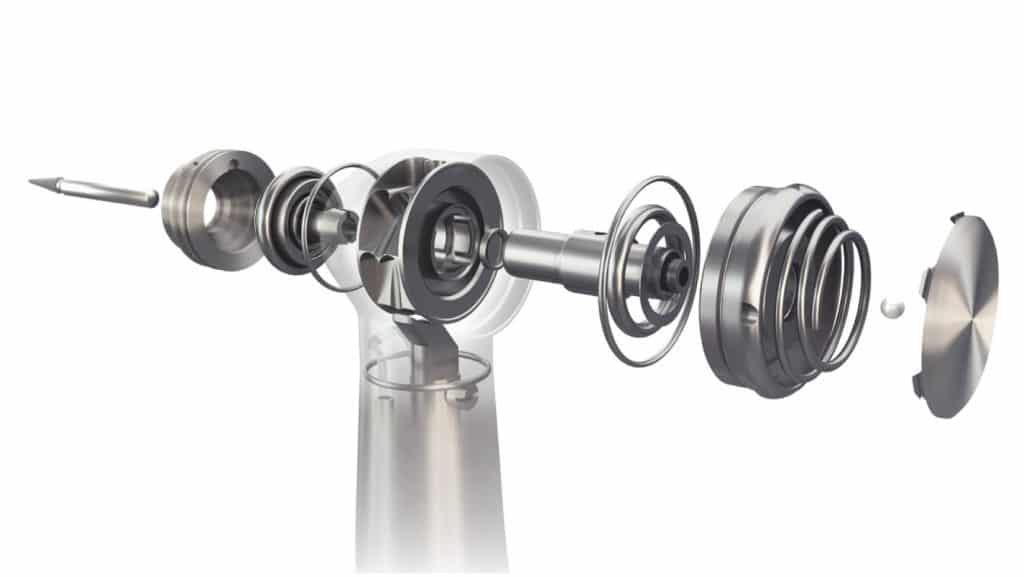Choosing your next high speed handpiece could be quite a complicated task.
The investment into air-driven high speed dental handpieces for your practice may prove to be a highly significant capital expense. Not only are these dental handpieces relatively expensive, but, you will also need to consider the operational costs and maintenance that will be required to keep the instruments running optimally on a long-term basis.
As a result, it is imperative that you – as a clinician – take the time to carefully consider the features associated with the devices, the overall reliability of the pieces, and the maintenance-based requirements when making a purchasing decision.
In this brief guide, we will provide you with the basic criteria for choosing air-driven dental handpieces for your practice.
Why are Handpieces Head Size and Angulation so important?
The best handpiece is the handpiece that suits you best because it needs to fit your hand shape. Handpieces are becoming more and more ergonomic.
In recent times, there has been a growing demand for precise dental procedures. Significant advancements have taken place in the key areas of modern dental practices, namely tooth preparation and implant placement, to cater to these evolving needs. Precision plays a pivotal role in enhancing the overall quality of dental procedures while simultaneously cutting down the time involved. That is why we need to focus on Handpieces Head Size and Angulation!
A safe, easy, and quick way to maintain your instruments! Handpiece Lubrication System is on Sale! 55$ NOW!
How to choose the right Handpiece Head Size and Angulation?
The first criterion that must be considered when purchasing high-speed dental handpieces is the head size and the overall angulation of the head.
A small head provides improved levels of visibility and patient access. A large head has a larger rotor that results in a higher output of power. In most instances, the angulation is set at 22.5 degrees.
This makes it easy for the instrument to remain in the sight of the dentist; however, this angle could result in the handpiece touching the maxillary arch due to restrictions in access to the posterior teeth. It is often best to opt for angulation that allows the posterior teeth to be reached and the patient’s comfort to be optimized.
Doctors want power so they can work efficiently. The bigger the head, the more powerful the handpiece. However, with the large head, the tradeoff is now access and vision; you cannot exactly see what you’re doing. Smaller heads provide better access and visibility but they are not as powerful.
Titanium LED Kavo NSK Turbines
100% Titanium Body
Anti-Retraction System
Angular Ceramic Bearings
Mini, Standard & Torque Head
24Watts Max Power
Titanium LED 1:1 Contra Angle
100% Titanium Body
-25% Weight reduction
Fits ANY E-Type Motor
Cellular Optic Glass Rod
Great Performance under heavy load (Torque)
Titanium LED 1:5 Contra Angle
100% Titanium Body
Anti Retraction System
5.500K LED Illumination
4 Cooling Sprays
Myonic® Angular Ceramic Bearings
The Effect of Sound in the Dental Office:
The connection between sound and human senses is undeniable, directly influencing the overall emotional well-being of an individual. Within dental offices, both dental staff and patients are exposed to a myriad of sounds, and these auditory experiences can be perceived as negative. In dental healthcare units, the presence of anxious and phobic patients is a common occurrence, with these individuals being particularly sensitive to both sound and touch. The heightened sensitivity to sound can lead anxious patients to become uncooperative and potentially more challenging to manage, often resulting in avoidance of dental visits. Additionally, age can play a significant role in how noise is perceived and the accompanying emotions it evokes. This is especially true for children, as aspects of dental treatment that evoke fear are often sensory in nature, such as the sound of a dental drill.
It is a known fact that dental professionals have a high risk of developing hearing loss. Much of the hearing loss experienced by practitioners directly relates to the use of loud dental handpieces, over time.
Not only does a loud handpiece hurt a dentist’s ears, but it may make patients uncomfortable and may even increase dental anxiety. It is best to opt for air-driven dental handpieces that operate in the range of 58 decibels to 71 decibels.
The Ergonomic Design of Modern Handpieces
Practitioners with relatively small hands face an increased risk of substantial fatigue when tasked with supporting an unbalanced load of this nature. Fortunately, there are new modern handpieces, namely made of Titanium, crafted specifically for weight-balancing purposes. These innovative titanium handpieces boast evenly distributed weight, tipping the scales at a mere 2.5 ounces, and have a unique touch feeling.
Many dentists use dental handpieces for several hours each day. This level of use may result in health issues such as carpal tunnel syndrome, pain, and nerve damage. You should always opt for those handpieces that have the ergonomic design of a wide, flared shape towards the end area of the instrument. This will help in reducing fatigue of the hand and the wrist.
In recent years, few modern manufacturers introduced a series of high-speed handpieces featuring significantly broader grip elements on the handpiece’s body, promoting a more comfortable hand position. The presence of texture translates to enhanced traction. This expanded grip concept has now been integrated into the design of a novel high-speed handpiece.
Furthermore, the texture and material on the instrument shaft play a crucial role in influencing a clinician’s pinch/grip. Therefore, incorporating some form of texture or ribbing proves beneficial in enabling clinicians to delicately grasp the handpiece while still maintaining control.
There are several considerations to choosing air-driven dental handpieces for your practices. In this guide, we have reviewed head size and head angulation, noise level, and ergonomic design.
Watch 100% Titanium LED Handpieces Video on Our YouTube Channel HERE

